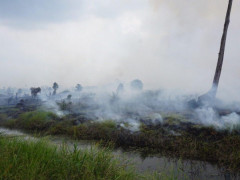Political Parties Overlooked Record in the Vice Presidential Debate
By AdminGovernment Commitments to Peat Restoration in Papua Must Be Met
To date, 80,000 ha of Papua peatland has been damaged due to commercial plantations, mining, and industrial activity. According to 2011 data from Jerat Papua, 155 companies have developed 25,527,497 ha in Papua, more than half of the province’s total area. As evidenced by this rapid development, both local and national government bodies have failed to meet their peatland restoration commitments in Papua.
Position Paper
Paradisea Foundation, YALI Papua, and Jerat Papua,
Part of the Papua Pantau Gambut Local Networks
In December 2016, President Joko Widodo signed Regulation No. 57/2016 on Peat Ecosystem Management and Protection, which prohibits land clearance in peatland areas. The national government – through the Peatland Restoration Agency (BRG) – has outlined strategies to restore two hectares of peatland in seven provinces of Indonesia, including Papua, by 2020.
Peatland is spread across 37 districts in Papua and West Papua. Based on data from the Indonesian Center for Agricultural Land Resources Research and Development (BBLSDLP) of the Ministry of Agriculture, peatland covers 3,681,673 hectares (ha) of Papua Island, consisting of 2,685,184 ha in Papua province and 1,023,489 ha in West Papua province.
The peatland in Papua province is in Mappi (479,848 ha), Membramo Raya (384,496 ha), Asmat (378,415 ha), Mimika (268,207 ha), Sarmi (203,909 ha), Boven Digoel (179,523 ha), and Tolikara (168,223 ha). Meanwhile, peatlands in West Papua are located in Teluk Bintuni (445,659 ha), South Sorong (287,905 ha), Sorong (126,201 ha), and Kaimana (107,436 ha).
Unfortunately, Papua’s peatlands are threatened by extensive land conversions. To date, 80,000 ha of Papua peatland has been damaged due to commercial plantations, mining, and industrial activity. According to 2011 data from Jerat Papua, 155 companies have developed 25,527,497 ha in Papua, more than half of the province’s total area.
Peat ecosystems take thousands of years to process, which makes them very unique. This is one reason why peatland cultivation requires extra care, ensuring that only plants that do not drain the peat ecosystem are introduced. Maintaining ecological balance preventatively through peatland management is less costly and time-consuming than restoration and rehabilitation once peatlands have been damaged.
Peatland degradation also accelerates climate change. Peatlands and forests store large amounts of carbon. In fact, according to BBLSDLP data, 97.94% of carbon stocks in Papua are in peatland areas. Ongoing degradation and deforestation undermine peatland forests’ natural roles storing carbon and reducing emissions that contribute to climate change. From 2000–2004, 190,994 ha of degraded peatland released more than 282 million tons of carbon dioxide emissions. Meanwhile, BBLSDLP data reveals that the deforestation of 38,000 ha of land annually produces more than 278 million tons of carbon dioxide emissions.
Unfortunately, both local and national government bodies have failed to meet their restoration commitments in Papua. This is evidenced by the ongoing destruction of peatland due to land conversion and the limited availability and inaccuracy of data on Papua peatlands.
For example, BBLSDLP, Wetlands International, and the BRG report significantly different figures for the size of Papua peatlands. BBLSDLP data shows 3,681,673 ha of peatland in Papua, while Wetlands International counts 7.97 million ha, and the BRG estimates six million ha. The absence of centralized data on and maps of peatlands on Papua Island reflects bad governance, which enables the exploitation of peatlands for production and mining.
Reflecting on peat conditions on Papua Island, we, Paradisea Foundation, YALI Papua, and Jerat Papua, members of the Pantau Gambut Papua Networks ask the national and local government to take the following action:
- Immediately realize their commitment to peatland and forest restoration and protection in Papua, as outlined in related regulations.
- Establish communication and tighten coordination lines between national and local government to reinforce commitments to Papua peat forest protection and restoration.
- Conduct national field research documenting the biophysical, social, and economic conditions of communities in peat ecosystems immediately.
Given that 30 million of the 32 million ha in Papua province is forest area, including peat forests, national and local government need to take a firm stance immediately to realize their peat restoration and protection commitments to the people of Papua.



